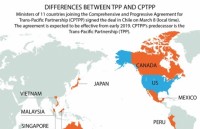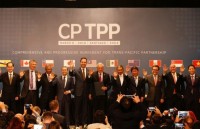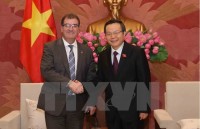
Canadian minister underlines Vietnam’s role in CPTPP negotiation
Latest
| TIN LIÊN QUAN | |
| CPTPP to tighten Vietnam-New Zealand partnership | |
| CPTPP signing date set in March | |
In an interview granted to the Vietnam News Agency on the sidelines of the official signing of the CPTPP in Chile, the Canadian minister spoke highly of the leadership of Vietnam’s Prime Minister and Minister of Industry and Trade during the process.
 |
| Canadian Minister of International Trade Francois – Philippe Champagne. |
Canada wishes to consolidate the relationship with Vietnam, he noted, adding that with CPTPP, the two nations can increase their trade exchange, particularly between small- and medium-sized enterprises of the two nations.
Canada and Vietnam will collaborate to ensure that the agreement will be effective and benefit people in line with commitments stated in the deal, the minister said, adding that he hopes the two countries will start with cutting tariffs to facilitate trade exchange.
He expressed his delight when Canada, together with Vietnam and other member nations, will establish regulations on trading in Asia-Pacific region in a fair, progressive and open manner, thus facilitating win-win, fair and balanced trade exchange.
Explaining the deal’s concepts of “comprehensive” and “progressive” initiated by Canada, the minister said the CPTPP aims to benefit not only big companies but also the people, adding that anyone can trade with new markets.
According to the Canadian minister, the CPTPP will benefit Vietnamese and Canadian people alike. The world will consider it a model for progressive and inclusive trade, he said.
The official signing of CPTPP took place in Santiago de Chile on March 8 (local time), with the participation of representatives from 11 member countries, namely Chile, Australia, Brunei, Canada, Malaysia, Mexico, Japan, New Zealand, Peru, Singapore and Vietnam.
CPTPP was launched a year ago after the US withdrew from the Trans-Pacific Partnership (TPP) agreement.
The content of CPTPP was basically unchanged from the original TPP with 8,000 pages, except for the suspended implementation of 22 provisions mainly related to intellectual property. It sets high criteria in numerous fields, including labour, the environment, intellectual property, digital economy and cyber security.
The pact will create one of the world’s largest free trade blocs with a combined market of 499 million people and GDP of around 10,100 billion USD, accounting for 13.5 percent of the global GDP.
The pact will come into force 60 days after it is fully ratified by at least six of the 11 members.
 | Differences between TPP and CPTPP 11 Asia-Pacific countries have just signed the trade pact formerly known as the Trans-Pacific Partnership (TPP) on the early morning of 9 March (Vietnam time). ... |
 | New Trans-Pacific trade deal reached in Chile The Comprehensive and Progressive Agreement for Trans-Pacific Partnership (CPTPP) trade deal was officially signed by 11 countries in the capital city of Santiago, Chile on ... |
 | Vietnam, Canada forge legislative ties Vice Chairman of the National Assembly (NA) Phung Quoc Hien called on Vietnam’s NA and Canada’s parliament to increase their exchange of delegations and law-making ... |

























